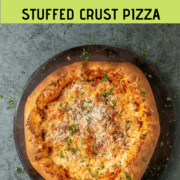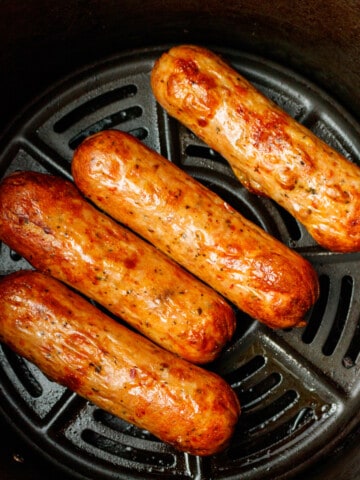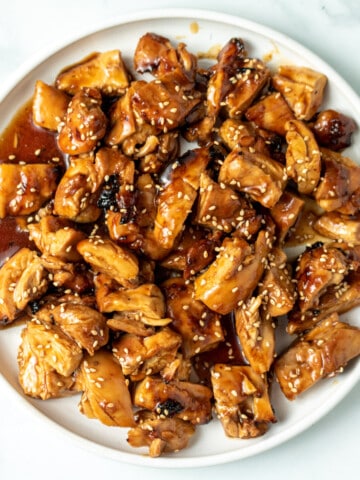You’ll be impressed with how easy it is to make stuffed crust pizza at home. Add your favorite toppings, use the best sauce and your favorite cheeses to make pizza night way more exciting. I love this recipe because it’s impressive but not a ton of extra work. Just make sure your pizza crust is sealed well so the cheese doesn’t leak out!

Jump to:
Tips and Tricks
What do you serve with this pizza? Cheese stuffed crust pizza is best served with something light to balance out the richness. I like to serve it with a side of seasonal vegetables or an easy side salad like this brussels sprout salad. Anything that is fresh tasting or acidic will go great with pizza!
How do you store cooked pizza? To store leftover pizza, allow it to cool to room temperature and then wrap it in tin foil tightly. Keep in the fridge for up to three days. You can also keep it in an airtight food storage container, I find foil is easier for this shape. It’s important to allow the pizza to cool before storing in the fridge to avoid soggy pizza.
How do you reheat leftover pizza? I like to eat my pizza cold from the fridge. If that’s not your jam you can reheat leftovers in the oven on a sheet tray at 350 F until warmed through (about 10 minutes). Another option if you don’t mind it being a little soggier is the microwave. I can also recommend reheating it in your air fryer at 325 F for three to five minutes.
Ingredients

- Marinara sauce - use your favorite homemade or jarred sauce
- Parmesan - freshly shredded is the best
- Pizza dough - Homemade or store bought
- String cheese - use full fat mozzarella
- Italian seasoning
- Fontina - A good flavorful melting cheese
- Cheddar
- Parsley - an optional garnish
- All purpose flour - for dusting your work surface and dough
See recipe card for quantities.
What are the best types of cheese to use on this pizza? For the stuffed crust part of the pizza it is important that you use full fat mozzarella string cheese. If you use reduced fat or fat free cheese it will not melt well. If you change the type of cheese stick (like a cheddar) it will not melt well and will become greasy.
As far as the topping cheese, I like to use a combination of fontina and cheddar cheese. Fontina melts well but has good flavor without being overpowering. Cheddar gives you the extra flavor. Both cheeses are great to keep in the house and can be used in a variety of recipes. To garnish the pizza I like to use freshly grated parmesan, but you can use your favorite. Other options are to use a part skim mozzarella to replace the fontina or a pecorino romano to replace the parmesan.
Do you use store bought or homemade dough? I personally buy my own pizza dough frozen from my local grocery store. However, if you’re feeling ambitious, an overnight pizza dough is pretty easy to make! For this recipe I would not recommend using an already pre-cooked pizza dough because then you cannot stuff the crust.
How do you choose the right mozzarella cheese? When you are looking at string cheese, make sure it is full fat mozzarella string cheese. You don’t want anything in a brine or that looks very wet because it’ll make your dough wet. You want the kind children (or adults) eat in the plastic wrapping. Specifically, get full fat mozzarella to ensure it melts well.

Method
How do you make stuffed crust pizza? Start by preheating your oven to 425 F and lightly flour your work surface and pizza dough. Stretch pizza dough out until thin and just barely fits on your pizza stone (or preferred pizza cooking vessel). Unwrap cheese sticks and tear in half lengthwise so you have eight to ten pieces of mozzarella sticks. Place these around the edge of the pizza with little to no gaps between pieces. Sprinkle the Italian seasoning over the cheese sticks. Starting in one spot, pull up the pizza dough to go over the seasoned mozzarella cheese sticks. Continue this process around the entire edge of the pizza.

Once your crust is secure, add your pizza sauce in a thin layer, using the back of a spoon to spread it out evenly inside the crust. Sprinkle the cheddar and fontina cheese evenly over the sauced portion of the pizza. Place pizza in the oven and cook for 17-22 minutes until pizza is golden brown and the cheese is melted. Remove pizza from the oven and allow it to rest for three to five minutes before cutting into slices. While still hot, sprinkle with parmesan and freshly chopped parsley and enjoy while warm.

Hint: Your pizza dough should be at room temperature to make it easier to work with!
How do you stretch pizza dough? The easiest way to stretch pizza dough is to have it at room temperature. Next, make sure your surface is well floured and flour the dough so it isn’t sticky. It’s easiest to start with a ball of dough that’s basically a circle. Starting in the middle, push down and out with one hand. Rotate the dough a quarter turn and continue doing this to slowly push out the dough. Rotate again and continue for a few turns. Once the dough is starting to get bigger, pick it up in both hands and allow gravity to pull it down, continuing to rotate it. Keep doing this but make sure it doesn’t get too thin. Continue this process until it’s about the size of your pizza stone. It is okay if it’s a little bigger than the pan because you’ll be pulling dough over the cheese sticks.
I can’t get my dough to stretch anymore, what can I do? If you’ve been stretching your dough and it keeps shrinking, let it rest for five minutes. Walking away for five to ten minutes will allow the dough to relax. Pizza dough is easier to stretch when it is relaxed.
How do you keep the cheese leaking from the crust? To keep the cheese inside the crust, I seal the dough really well. I work slowly around the edges and make sure the dough that I pulled over the cheese stick is sticking to the base of the pizza. Keep pushing and pinching! If necessary, use a fork to crimp it together. Try not to make any holes in the crust.

Can I use full cheese sticks instead of halves? Yes, you can because I believe you should measure cheese with your heart. If you want the crust extra cheesy, go for it. You will probably need eight to ten full cheese sticks.
Variations
What toppings can you add? You can add your favorite pizza toppings! Make sure any meat products are cooked fully before adding to the top of a pizza. Vegetables can go on raw or cooked depending on the texture you’re looking for. Be sure not to add too many toppings or you may have a soggy pizza.
- Vegetarian - lemon and broccoli white pizza
- Use up leftovers - butternut squash pizza
- Meat lovers - add your favorite cooked meat like sausage crumbles, pepperoni or meatballs
Equipment
What’s the best pan/cooking vessel to use? I use a pizza stone to make my pizza. I’ve had it forever and it works for us. Another option is a greased baking sheet or a baking steel. Any of these will make a delicious pizza!
Should I preheat the pizza stone? I do not preheat my pizza stone because it’s physically too hard for me to move it around while hot. You can definitely preheat yours if you like, the pizza will cook faster so keep an eye on it.
Top tip
Always let your pizza rest for three to five minutes to keep the toppings from sliding around while you cut it. This will also allow the stuffed crust to cool enough to not oozy out at once!

Homemade Stuffed Crust Pizza
Ingredients
- 14-16 oz of fresh pizza dough room temperature
- All purpose flour for dusting
- 4-5 full fat mozzarella sticks string cheese
- 1 tablespoon dried Italian seasoning
- ¼ cup marinara sauce
- ½ cup freshly shredded cheddar cheese
- ½ cup freshly shredded fontina cheese
- 2 tablespoons freshly shredded parmesan
- Chopped fresh parsley for garnish
Instructions
- Preheat your oven to 425 F.
- Lightly flour your work surface and pizza dough. Stretch pizza dough out until thin and just barely fits on your pizza stone. Place on a pizza stone or an oiled sheet pan, it is okay if it hangs over a little bit.
- Unwrap cheese sticks and tear in half lengthwise so you have 8-10 pieces of mozzarella sticks. Place these around the edge of the pizza with little to no gaps between pieces.
- Sprinkle the Italian seasoning over the cheese sticks.
- Starting in one spot, pull up the pizza dough to go over the seasoned mozzarella cheese sticks. Be sure to seal well with your fingers, pizza dough should stay in place without any help. Continue this process around the entire edge of the pizza.
- Add your pizza sauce in a thin layer, using the back of a spoon to spread it out evenly inside the ring of stuffed crust.
- Sprinkle the cheddar and fontina cheese evenly over the sauced portion of the pizza. This is also a good time to add additional toppings.
- Place pizza in the oven and cook for 17-22 minutes until pizza is golden brown and the cheese is melted and bubbly.
- Remove pizza from the oven and allow it to rest for 3-5 minutes before cutting into slices. While still hot, sprinkle with parmesan and freshly chopped parsley. Cut into 6-8 slices and serve warm.
Notes and Accommodations
- Low fat or fat free mozzarella sticks or other types of cheese sticks aren’t recommended because they don’t melt well in this situation. Save those for snacks and go for the full fat mozzarella string cheese sticks.
- You can bake pizza on a pizza stone, baking steel or oiled baking sheet.
- I do not pre-heat our pizza stone because it’s a challenge to transfer the pizza to the hot pizza stone in the oven for me. If you do preheat your vessel, cooking time will vary.
- You can use homemade sauce or jarred sauce for this recipe.
- Parsley is an optional garnish, fresh basil will also work. If you don’t have fresh herbs, sprinkle some dried oregano or Italian seasoning.
- Store in the fridge wrapped in foil for 2-3 days.
- Reheat pizza in the oven at 350 F until warmed through, in the microwave or using your air fryer. I usually eat it cold from the fridge.
- Additional toppings can be added with the shredded cheese, be careful not to overload the pizza or it’ll get soggy. All toppings should be fully cooked before adding to the pizza (like bacon, sausage, meatballs etc).
Food safety
- Cook to a minimum temperature of 165 °F (74 °C)
- Do not use the same utensils on cooked food, that previously touched raw meat
- Wash hands after touching raw meat
- Don't leave food sitting out at room temperature for extended periods
- Never leave cooking food unattended
- Use oils with high smoking point to avoid harmful compounds
- Always have good ventilation when using a gas stove





